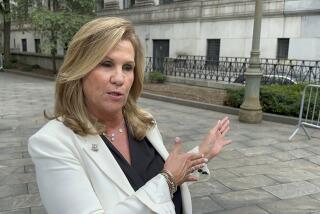Victims Lining Up to Tap Terrorists’ Frozen Assets
- Share via
WASHINGTON — While the U.S. government expands its campaign to find and freeze the assets of Osama bin Laden and his supporters, a line of thousands of terrorism victims already is forming to share in those financial spoils of war.
They are Kenyans--blinded, maimed, orphaned or widowed by the 1998 embassy bombing that federal prosecutors have tied to Bin Laden, his lieutenants and operatives. Washington attorney Philip Musolino, who represents more than 1,000 of them, filed briefs in federal court here earlier this week seeking to clear the way for them to claim at least some of the terrorists’ wealth.
In a separate lawsuit, Oakland-based civil rights lawyer John Burris also said he plans to lay claim to a share of the frozen funds. He represents a group of 2,700 other Kenyan victims from the embassy blast, which killed 212 people and injured 5,000 others.
Bin Laden and his operatives have been indicted in federal court for the bombings of U.S. embassies in Kenya and Tanzania, and the Saudi exile is the primary suspect in the Sept. 11 hijacking attacks. U.S. Treasury Department officials estimate they have frozen more than $350 million tied to Bin Laden, Afghanistan’s ruling Taliban and their associates over the last two years, according to Treasury Department records. Still, the victims face an uphill legal fight to get it.
“Our position has been since the beginning that, to the extent the government has located and frozen any assets anywhere in the world of Bin Laden or his associates, the Kenyan victims deserve a share of that,” said Musolino, who filed his class-action suit against both Bin Laden and the U.S. government in January 1999.
“We believe our clients should have the first opportunity, because they have been waiting three years,” Musolino said.
Burris said that to seek a share of the frozen funds he may add Bin Laden and the Taliban as defendants in the embassy bombing suit he filed here against the U.S. government. He conceded that, with so many American victims in the latest attacks, “we’ll probably have to stand in line. But we can at least stake a claim.”
The U.S. attorney’s office in Washington, which is defending the government in both civil cases, declined to comment on the attempt to go after the frozen assets.
Indeed, securing any of those funds to compensate victims of terrorist attacks tied to Al Qaeda may prove an even more daunting task than tracking the assets, according to lawyers, prosecutors and a handful of federal court decisions.
The rare template for such attempts is the case of Alisa Flatow, a 20-year-old New Jersey student who was killed by a suicide bomber in the Palestinian-controlled Gaza Strip in April 1995. Flatow’s father sued the Islamic Republic of Iran and several senior Iranian officials in federal court here, asserting that the government in Tehran sponsored the truck bombing.
Flatow won the case: U.S. District Judge Royce C. Lamberth ordered that the family be paid $225 million in punitive damages and $26 million in compensation. And the money was there: frozen in Iranian accounts blocked by the U.S. Treasury Department.
That was three years ago. In January, the U.S. Treasury paid the family $26 million from the frozen-fund account. That payment came only after Congress passed the Victims of Trafficking and Violence Protection Act last year that specifically sanctions such compensation for the plaintiffs in that case.
But the act doesn’t cover punitive damages, so the Flatow family is still trying to collect the rest. A Treasury official says the department acts as a “paymaster” that safeguards the frozen funds against competing claims until it is ordered to release them. In most such cases, that has taken years--and an act of Congress.
Against that backdrop, the attorneys chasing the Bin Laden and Taliban wealth for the Kenyans say the legal road ahead is long and largely uncharted.
Until last month’s attacks on the World Trade Center and the Pentagon, most of their efforts focused on determining whether the U.S. State Department and intelligence agencies were negligent in the Nairobi bombing.
Musolino’s case alleges that key State Department officials in Washington ignored warnings that the embassy in Nairobi was a target and that the government’s response to an upsurge in global terrorism against American targets was “haphazard and ineffective.”
In recent weeks, though, Musolino has focused on Bin Laden. He is seeking a court order that would find the Saudi exile and his Al Qaeda network in default in the case for not filing a response to the complaint within a reasonable time limit.
That court order would be the first step in seeking a financial judgment against the terror network. Musolino’s latest filing on Wednesday asserts that the U.S. court has jurisdiction over Al Qaeda’s frozen assets, because the Sept. 11 attacks demonstrated Al Qaeda’s “extensive contact with and physical presence within the United States.”
“The extensive financial network which funded both the terrorist acts at issue in this [embassy bombings] case as well as the September 2001 attack has been shown to operate within the United States’ borders and within its financial institutions,” the brief states.
Bin Laden and his top lieutenants have been indicted, and four members of his organization were convicted in May by a U.S. district court jury in New York City on charges that included conspiracy and murder in the 1998 attack. Sentencing for the four is scheduled for Oct. 18.
During the 76-day criminal trial in New York, victims described their injuries in court:
* Father John Kiongo Kariuki, a Kenyan Roman Catholic priest, told the jury how he was blinded and his brother and niece were killed in the blast. He had come to the embassy to get a U.S. visa for his niece.
* Samuel Nganga, a 53-year-old Kenyan government broker doing business at the nearby Ufundi Cooperative House, which was destroyed by the bomb, told of being trapped in rubble for hours with a broken leg, and of talking to an American woman trapped nearby as she slowly died.
* Pininah Muhoho was waiting at a nearby bus stop when the explosion blew out his teeth.
* Elijah Mutie, 37, a Kenyan consultant in the nearby National Housing Corporation, was blown out of his first-floor window by the blast, which slashed his face and broke three of his ribs.
* Tobias Otieno, a 51-year-old Kenyan commercial specialist at the embassy, lost both of his eyes, his left hand and two of his best friends, telling the jury: “I thought it was the end of the world.”
President Clinton ordered the Treasury Department to hunt Bin Laden’s wealth in a national-emergency order issued Aug. 20, 1998, 13 days after suicide-bomb attacks on the embassies in Kenya and Tanzania. But no money was frozen under that order, a Treasury official said this week.
Afghanistan’s ruling party was targeted in a similar executive order Clinton signed a year later, on July 4, 1999. Treasury Department documents show that the U.S. froze $254 million of the Taliban’s funds in America and elsewhere.
Since then, the U.S. has blocked $100 million more in America and abroad, according to Treasury spokesperson Tasia Scolinos. That includes money frozen before and after President Bush signed an order on Sept. 25 adding new Bin Laden-linked companies, organizations and individuals to the terror list.
More to Read
Sign up for Essential California
The most important California stories and recommendations in your inbox every morning.
You may occasionally receive promotional content from the Los Angeles Times.













